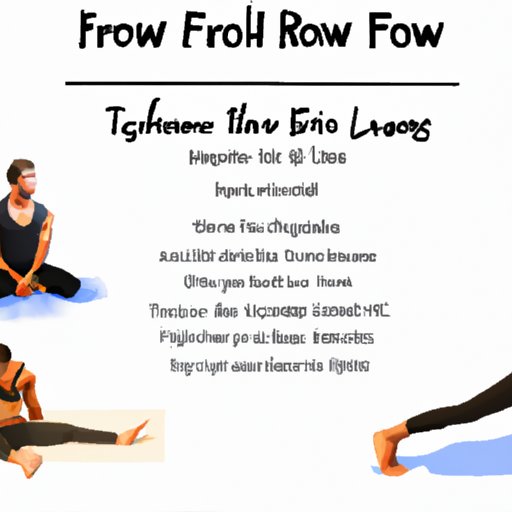Introduction
Yoga has become increasingly popular in recent years due to its many health benefits, from improved flexibility and strength to increased focus and mental clarity. One particular type of yoga that has gained traction is yoga flow. But what exactly is yoga flow?
Yoga flow, also known as Vinyasa or Power yoga, is a dynamic style of yoga that combines poses with breath work. It is a continuous flow of movement that links each pose together, allowing you to move more freely and naturally. This type of yoga focuses on developing strength and flexibility while also calming the mind.
In this article, we will explore why you should incorporate yoga flow into your practice, the different types of yoga flow, tips for practicing yoga flow at home, and how to use yoga flow to enhance your overall well-being.

The Benefits of Incorporating Yoga Flow into Your Practice
Yoga flow offers a wide range of benefits that can improve both your physical and mental health. Here are some of the most notable benefits of incorporating yoga flow into your practice:
Improved Flexibility and Strength
One of the most obvious benefits of yoga flow is improved flexibility and strength. The continuous flow of movement helps to stretch and strengthen your muscles, which can result in improved posture and balance. This can help you avoid injury during other physical activities, such as running or weightlifting.
Increased Focus and Mental Clarity
Yoga flow is a great way to improve your focus and mental clarity. The combination of movement and breathwork helps to clear your mind and bring you back to the present moment. This can help to reduce anxiety and stress levels, and improve your overall mental wellbeing.
Stress Relief and Relaxation
Yoga flow is a great way to relax and unwind after a long day. The gentle movements and deep breathing help to lower your heart rate and blood pressure, which can lead to a feeling of calm and relaxation. This can help to reduce stress levels and promote better sleep.

Exploring the Different Types of Yoga Flow
When it comes to yoga flow, there are several different styles to choose from. Here are some of the most popular types of yoga flow:
Vinyasa Flow
Vinyasa flow is one of the most popular types of yoga flow. It is a dynamic style of yoga that combines poses with breath work. It is a continuous flow of movement that links each pose together, allowing you to move more freely and naturally.
Ashtanga Flow
Ashtanga flow is a more intense style of yoga flow. It follows a specific sequence of poses that are connected with breath work. This type of yoga is great for those looking for a challenging workout that will help build strength and improve flexibility.
Power Flow
Power flow is another popular type of yoga flow. It is a faster-paced form of yoga that focuses on building strength and improving balance. The poses are linked together in a continuous flow, and the classes often involve more challenging postures.
Tips for Practicing Yoga Flow at Home
If you’re interested in trying yoga flow but don’t want to go to a studio, there are plenty of ways to practice yoga flow at home. Here are some tips to help you get started:
Set up a Comfortable Space
The first step to practicing yoga flow at home is to create a comfortable space. Find a quiet spot in your home where you won’t be disturbed, and make sure you have enough room to move around freely.
Find an Instructor or Video to Follow
Once you’ve set up your space, the next step is to find an instructor or video to follow. There are plenty of online resources available, so take your time to find the right one for you.
Take it Slow
When starting out with yoga flow, it’s important to take it slow. Don’t try to rush through the poses or push yourself too hard. Listen to your body and only do what feels comfortable.
How to Use Yoga Flow to Enhance Your Overall Well-Being
In addition to the physical benefits of yoga flow, there are also mental and emotional benefits. Here are some tips on how to use yoga flow to enhance your overall wellbeing:
Create Positive Affirmations
As you practice yoga flow, create positive affirmations to keep your mind focused. This can help to reduce stress levels and boost your confidence.
Make Time for Yourself
It’s important to make time for yourself. Set aside a few minutes each day to practice yoga flow and allow yourself to relax and unwind.
Listen to Your Body
Most importantly, listen to your body. If something feels uncomfortable or painful, stop and modify the pose. Yoga flow is all about finding a balance between effort and ease.
Conclusion
Yoga flow is an excellent way to increase your flexibility and strength, improve your focus, reduce stress and enhance your overall wellbeing. It is a dynamic style of yoga that combines poses with breath work, allowing you to move more freely and naturally. There are several different types of yoga flow to choose from, and it’s important to find an instructor or video to follow when practicing at home. Finally, remember to create positive affirmations, make time for yourself and listen to your body. With regular practice, you will soon start to feel the benefits of yoga flow.


